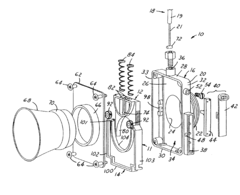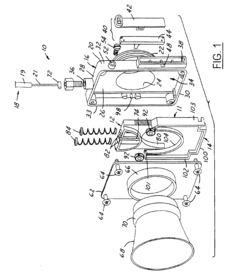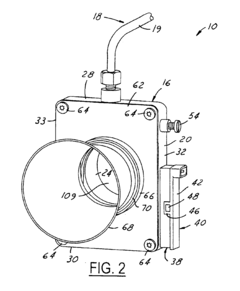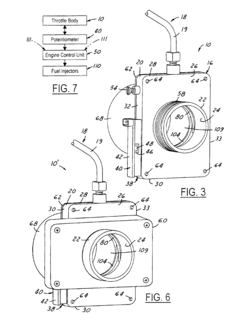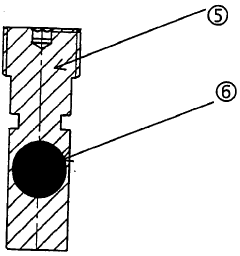Investigating Throttle Body Response in Microgrid Operations
JUL 18, 20259 MIN READ
Generate Your Research Report Instantly with AI Agent
Patsnap Eureka helps you evaluate technical feasibility & market potential.
Microgrid Throttle Body Evolution and Objectives
The evolution of throttle body technology in microgrid operations has been a critical aspect of power system control and management. Initially developed for automotive applications, throttle bodies have found new purpose in the realm of microgrids, where they play a crucial role in regulating power flow and maintaining system stability.
In the early stages of microgrid development, throttle bodies were primarily used for basic load management. As microgrids became more complex, integrating various renewable energy sources and storage systems, the need for more sophisticated throttle body control mechanisms emerged. This led to the development of electronic throttle bodies with enhanced response times and precision control capabilities.
The primary objective of investigating throttle body response in microgrid operations is to optimize power distribution and enhance overall system efficiency. By improving throttle body performance, microgrid operators aim to achieve faster response times to sudden load changes, smoother integration of intermittent renewable energy sources, and more effective management of energy storage systems.
Another key goal is to enhance the resilience and reliability of microgrids. Advanced throttle body control systems can help microgrids quickly adapt to grid disturbances, islanding events, and other operational challenges. This improved responsiveness is crucial for maintaining power quality and ensuring uninterrupted service to critical loads.
The evolution of throttle body technology in microgrids has also been driven by the need for greater flexibility in power system architecture. Modern throttle bodies are designed to operate effectively in both grid-connected and islanded modes, allowing for seamless transitions between these operational states. This flexibility is essential for maximizing the benefits of distributed energy resources and enabling microgrids to provide ancillary services to the main grid.
As microgrid technology continues to advance, the objectives for throttle body response are becoming increasingly ambitious. Current research focuses on developing predictive control algorithms that can anticipate load changes and adjust throttle body settings proactively. This approach aims to minimize power fluctuations and improve overall system stability.
Furthermore, the integration of artificial intelligence and machine learning techniques into throttle body control systems is emerging as a promising area of development. These advanced technologies have the potential to optimize throttle body performance in real-time, adapting to changing environmental conditions and system requirements with unprecedented efficiency.
In the early stages of microgrid development, throttle bodies were primarily used for basic load management. As microgrids became more complex, integrating various renewable energy sources and storage systems, the need for more sophisticated throttle body control mechanisms emerged. This led to the development of electronic throttle bodies with enhanced response times and precision control capabilities.
The primary objective of investigating throttle body response in microgrid operations is to optimize power distribution and enhance overall system efficiency. By improving throttle body performance, microgrid operators aim to achieve faster response times to sudden load changes, smoother integration of intermittent renewable energy sources, and more effective management of energy storage systems.
Another key goal is to enhance the resilience and reliability of microgrids. Advanced throttle body control systems can help microgrids quickly adapt to grid disturbances, islanding events, and other operational challenges. This improved responsiveness is crucial for maintaining power quality and ensuring uninterrupted service to critical loads.
The evolution of throttle body technology in microgrids has also been driven by the need for greater flexibility in power system architecture. Modern throttle bodies are designed to operate effectively in both grid-connected and islanded modes, allowing for seamless transitions between these operational states. This flexibility is essential for maximizing the benefits of distributed energy resources and enabling microgrids to provide ancillary services to the main grid.
As microgrid technology continues to advance, the objectives for throttle body response are becoming increasingly ambitious. Current research focuses on developing predictive control algorithms that can anticipate load changes and adjust throttle body settings proactively. This approach aims to minimize power fluctuations and improve overall system stability.
Furthermore, the integration of artificial intelligence and machine learning techniques into throttle body control systems is emerging as a promising area of development. These advanced technologies have the potential to optimize throttle body performance in real-time, adapting to changing environmental conditions and system requirements with unprecedented efficiency.
Market Analysis for Microgrid Control Systems
The market for microgrid control systems has experienced significant growth in recent years, driven by the increasing demand for reliable and efficient energy management solutions. As the global energy landscape shifts towards decentralized and renewable sources, microgrids have emerged as a crucial component in ensuring grid stability and resilience. The market for microgrid control systems is expected to continue its upward trajectory, with a compound annual growth rate projected to exceed 15% over the next five years.
Key factors contributing to this market expansion include the rising adoption of renewable energy sources, growing concerns over grid reliability, and the need for energy independence in remote or disaster-prone areas. Governments worldwide are implementing supportive policies and incentives to promote microgrid development, further fueling market growth. Additionally, the integration of advanced technologies such as artificial intelligence, machine learning, and Internet of Things (IoT) into microgrid control systems is enhancing their capabilities and attracting more customers.
The market for microgrid control systems can be segmented based on application areas, including commercial and industrial, military, healthcare, education, and residential sectors. Among these, the commercial and industrial segment currently holds the largest market share, driven by the need for uninterrupted power supply and energy cost reduction in manufacturing and data center operations.
Geographically, North America leads the market, followed by Europe and Asia-Pacific. The United States, in particular, has seen substantial investment in microgrid projects, supported by government initiatives and a strong focus on grid modernization. Developing economies in Asia-Pacific, such as India and China, are expected to witness rapid growth in the coming years due to increasing electrification efforts and the need to address power reliability issues.
The competitive landscape of the microgrid control systems market is characterized by the presence of both established players and innovative startups. Major companies in this space include Siemens, ABB, General Electric, and Schneider Electric, who offer comprehensive microgrid solutions. These industry leaders are continuously investing in research and development to enhance their product offerings and maintain their market positions.
Emerging trends in the microgrid control systems market include the development of more sophisticated energy management algorithms, improved integration with existing grid infrastructure, and enhanced cybersecurity features. The increasing focus on sustainability and carbon reduction goals is also driving the adoption of microgrid solutions that can optimize the use of renewable energy sources and reduce reliance on fossil fuels.
As the market for microgrid control systems continues to evolve, challenges such as high initial investment costs and regulatory hurdles remain. However, the long-term benefits of improved energy reliability, reduced operational costs, and environmental sustainability are expected to outweigh these challenges, driving further market growth and innovation in the coming years.
Key factors contributing to this market expansion include the rising adoption of renewable energy sources, growing concerns over grid reliability, and the need for energy independence in remote or disaster-prone areas. Governments worldwide are implementing supportive policies and incentives to promote microgrid development, further fueling market growth. Additionally, the integration of advanced technologies such as artificial intelligence, machine learning, and Internet of Things (IoT) into microgrid control systems is enhancing their capabilities and attracting more customers.
The market for microgrid control systems can be segmented based on application areas, including commercial and industrial, military, healthcare, education, and residential sectors. Among these, the commercial and industrial segment currently holds the largest market share, driven by the need for uninterrupted power supply and energy cost reduction in manufacturing and data center operations.
Geographically, North America leads the market, followed by Europe and Asia-Pacific. The United States, in particular, has seen substantial investment in microgrid projects, supported by government initiatives and a strong focus on grid modernization. Developing economies in Asia-Pacific, such as India and China, are expected to witness rapid growth in the coming years due to increasing electrification efforts and the need to address power reliability issues.
The competitive landscape of the microgrid control systems market is characterized by the presence of both established players and innovative startups. Major companies in this space include Siemens, ABB, General Electric, and Schneider Electric, who offer comprehensive microgrid solutions. These industry leaders are continuously investing in research and development to enhance their product offerings and maintain their market positions.
Emerging trends in the microgrid control systems market include the development of more sophisticated energy management algorithms, improved integration with existing grid infrastructure, and enhanced cybersecurity features. The increasing focus on sustainability and carbon reduction goals is also driving the adoption of microgrid solutions that can optimize the use of renewable energy sources and reduce reliance on fossil fuels.
As the market for microgrid control systems continues to evolve, challenges such as high initial investment costs and regulatory hurdles remain. However, the long-term benefits of improved energy reliability, reduced operational costs, and environmental sustainability are expected to outweigh these challenges, driving further market growth and innovation in the coming years.
Current Challenges in Throttle Body Response
The integration of throttle body response mechanisms in microgrid operations presents several significant challenges that require careful consideration and innovative solutions. One of the primary obstacles is the inherent complexity of microgrid systems, which often incorporate diverse energy sources, storage systems, and load profiles. This complexity makes it difficult to accurately model and predict the dynamic behavior of the throttle body within the microgrid environment.
Another critical challenge lies in the need for rapid response times. Microgrids must be capable of quickly adjusting to fluctuations in power supply and demand, often within milliseconds. The throttle body, as a key component in this process, must be able to react swiftly and precisely to maintain system stability. However, achieving such rapid response times while ensuring accuracy and reliability remains a significant technical hurdle.
The issue of scalability also poses a considerable challenge. As microgrids grow in size and complexity, the throttle body response mechanisms must be able to adapt and scale accordingly. This scalability requirement often conflicts with the need for precise control, creating a delicate balance that engineers must navigate.
Furthermore, the variability of renewable energy sources commonly integrated into microgrids adds another layer of complexity to throttle body response. Solar and wind power, for instance, are inherently intermittent, which can lead to rapid and unpredictable changes in power generation. The throttle body must be capable of responding to these fluctuations effectively, a task that becomes increasingly challenging as the proportion of renewable energy in the microgrid increases.
Interoperability between different components and systems within the microgrid is another significant challenge. The throttle body must be able to communicate and coordinate seamlessly with various control systems, energy management systems, and other components. Achieving this level of integration while maintaining optimal performance is a complex task that requires advanced communication protocols and control algorithms.
Lastly, the need for robust fault tolerance and reliability presents an ongoing challenge. Microgrids often operate in critical environments where power stability is paramount. The throttle body response mechanism must be designed to function reliably under a wide range of conditions and to fail safely in the event of a malfunction. Balancing this requirement with the need for high performance and efficiency is a significant engineering challenge that continues to drive research and development in this field.
Another critical challenge lies in the need for rapid response times. Microgrids must be capable of quickly adjusting to fluctuations in power supply and demand, often within milliseconds. The throttle body, as a key component in this process, must be able to react swiftly and precisely to maintain system stability. However, achieving such rapid response times while ensuring accuracy and reliability remains a significant technical hurdle.
The issue of scalability also poses a considerable challenge. As microgrids grow in size and complexity, the throttle body response mechanisms must be able to adapt and scale accordingly. This scalability requirement often conflicts with the need for precise control, creating a delicate balance that engineers must navigate.
Furthermore, the variability of renewable energy sources commonly integrated into microgrids adds another layer of complexity to throttle body response. Solar and wind power, for instance, are inherently intermittent, which can lead to rapid and unpredictable changes in power generation. The throttle body must be capable of responding to these fluctuations effectively, a task that becomes increasingly challenging as the proportion of renewable energy in the microgrid increases.
Interoperability between different components and systems within the microgrid is another significant challenge. The throttle body must be able to communicate and coordinate seamlessly with various control systems, energy management systems, and other components. Achieving this level of integration while maintaining optimal performance is a complex task that requires advanced communication protocols and control algorithms.
Lastly, the need for robust fault tolerance and reliability presents an ongoing challenge. Microgrids often operate in critical environments where power stability is paramount. The throttle body response mechanism must be designed to function reliably under a wide range of conditions and to fail safely in the event of a malfunction. Balancing this requirement with the need for high performance and efficiency is a significant engineering challenge that continues to drive research and development in this field.
Existing Throttle Body Response Solutions
01 Electronic throttle control systems
Electronic throttle control systems improve throttle body response by using sensors and actuators to precisely control the throttle opening. These systems can adjust throttle position based on various inputs, providing faster and more accurate response to driver inputs and engine conditions.- Electronic throttle control systems: Electronic throttle control systems improve throttle body response by using sensors and actuators to precisely control the throttle opening. These systems can adjust throttle position based on various inputs, providing faster and more accurate response to driver input and engine conditions.
- Throttle body design optimization: Optimizing throttle body design can enhance response characteristics. This includes improvements in airflow dynamics, reducing friction in moving parts, and using lightweight materials for faster actuation. Advanced designs may incorporate features like variable geometry or multi-stage openings for better control across different operating conditions.
- Sensor integration for improved feedback: Integrating advanced sensors into the throttle body system provides more accurate and real-time feedback on throttle position, airflow, and engine conditions. This improved data allows for faster and more precise adjustments to throttle opening, enhancing overall response and performance.
- Adaptive learning and calibration techniques: Implementing adaptive learning algorithms and advanced calibration techniques allows the throttle control system to optimize its response over time. These systems can adjust to changes in engine conditions, driving habits, and environmental factors, continuously improving throttle body response and overall engine performance.
- Integration with other vehicle systems: Enhancing throttle body response through integration with other vehicle systems such as transmission control, traction control, and engine management systems. This holistic approach allows for coordinated adjustments across multiple systems, resulting in improved overall vehicle responsiveness and performance.
02 Throttle body design optimization
Optimizing the design of throttle bodies can enhance response characteristics. This includes improvements in airflow dynamics, reducing friction in moving parts, and using lightweight materials for faster actuation. Advanced manufacturing techniques and materials can contribute to more responsive throttle bodies.Expand Specific Solutions03 Adaptive throttle control algorithms
Implementing adaptive control algorithms in engine management systems can improve throttle body response. These algorithms can learn and adjust to driver behavior, environmental conditions, and vehicle performance characteristics over time, resulting in more responsive and efficient throttle operation.Expand Specific Solutions04 Integration with other vehicle systems
Integrating throttle control with other vehicle systems such as transmission control, traction control, and stability control can enhance overall throttle response. This system-wide approach allows for more coordinated and responsive vehicle behavior across various driving conditions.Expand Specific Solutions05 Mechanical improvements in throttle linkage
Enhancing the mechanical aspects of throttle linkage can improve response times. This includes using low-friction materials, optimizing spring rates, and designing more efficient linkage geometries. These improvements can reduce lag and provide more direct control over throttle opening.Expand Specific Solutions
Key Microgrid Control System Manufacturers
The investigation of throttle body response in microgrid operations is at a critical juncture, with the market showing significant growth potential. The industry is in a transitional phase, moving from early adoption to mainstream implementation. Market size is expanding rapidly, driven by increasing demand for efficient energy management in smart grids. Technologically, the field is advancing, with companies like Mitsubishi Electric, DENSO, and Bloom Energy leading innovation. These firms are developing sophisticated control systems and integrating AI for optimized throttle response. However, the technology is not yet fully mature, with ongoing research at institutions like North Carolina State University and Shanghai University of Electric Power focusing on improving reliability and efficiency in diverse microgrid environments.
Mitsubishi Electric Corp.
Technical Solution: Mitsubishi Electric has developed an advanced throttle body control system for microgrid operations, focusing on rapid response and precise regulation. Their solution incorporates a high-speed microcontroller and adaptive control algorithms to optimize throttle body performance in varying microgrid conditions. The system utilizes real-time data from multiple sensors to adjust throttle position with millisecond-level precision, ensuring stable power output and efficient fuel consumption[1]. Additionally, Mitsubishi's throttle body integrates seamlessly with their comprehensive microgrid management platform, allowing for coordinated control of multiple power sources and loads within the microgrid ecosystem[3].
Strengths: Rapid response time, precise control, and integration with broader microgrid management systems. Weaknesses: Potentially higher cost due to advanced components and complexity in implementation for smaller-scale microgrids.
ABB Group
Technical Solution: ABB has engineered a sophisticated throttle body response system for microgrid applications, emphasizing reliability and adaptability. Their solution employs a digital twin approach, creating a virtual model of the throttle body that continuously optimizes performance based on real-world data[2]. The system features advanced predictive maintenance capabilities, using machine learning algorithms to anticipate potential issues before they occur. ABB's throttle body control is designed to operate efficiently across a wide range of microgrid configurations, from small-scale residential systems to large industrial complexes. The company has also implemented a unique "fast-start" feature that allows for rapid throttle response during sudden load changes or grid disturbances[4].
Strengths: Highly adaptable to various microgrid scales, predictive maintenance capabilities, and innovative digital twin technology. Weaknesses: May require significant computational resources and specialized expertise for implementation and maintenance.
Innovative Throttle Body Response Techniques
Throttle body
PatentInactiveUS6920864B1
Innovation
- A throttle body design featuring linear reciprocating first and second plates that define a variable flow area, allowing for increased air flow without obstruction, combined with a simple and economical potentiometer sensor for position detection, facilitating adaptable and cost-effective engine control.
Proportional valve and method of detecting the position of a throttle body in a valve
PatentInactiveGB2386670B
Innovation
- Integration of a force detector with the return spring to measure the force developed by the spring, which is used to derive the throttle body position.
- Incorporation of the force detector into the adjustment screw, allowing for a compact design and easy integration into existing valve structures.
- Flexibility in force detector placement, either at the end of the adjustment screw or in a transverse bore, allowing for adaptability to different valve designs.
Microgrid Regulatory Framework
The regulatory framework for microgrids plays a crucial role in shaping their development, operation, and integration into the broader energy landscape. As microgrids continue to gain prominence in the energy sector, governments and regulatory bodies are adapting existing policies and creating new ones to address the unique challenges and opportunities presented by these localized power systems.
At the federal level, the Federal Energy Regulatory Commission (FERC) has taken steps to facilitate microgrid integration into the larger grid. FERC Order 2222, issued in 2020, allows distributed energy resources, including those within microgrids, to participate in wholesale electricity markets. This order aims to enhance grid flexibility and resilience while providing new revenue streams for microgrid operators.
State-level regulations vary significantly across the United States, reflecting diverse energy priorities and market structures. Some states, such as California and New York, have implemented comprehensive microgrid programs and policies. California's Electric Program Investment Charge (EPIC) provides funding for microgrid demonstration projects, while New York's NY Prize initiative supports the development of community microgrids.
Interconnection standards are a critical component of the regulatory framework, ensuring safe and reliable integration of microgrids with the main grid. IEEE 1547-2018 provides a standardized approach for interconnecting distributed energy resources, including microgrids, with electric power systems. This standard addresses issues such as voltage regulation, power quality, and islanding detection.
Regulatory bodies are also grappling with tariff structures for microgrids. Some jurisdictions have implemented specific microgrid tariffs that account for the unique characteristics of these systems, such as their ability to island from the main grid and provide ancillary services. These tariffs aim to balance the interests of microgrid operators, utilities, and end-users.
Environmental regulations play a significant role in shaping microgrid development. Many jurisdictions have implemented renewable portfolio standards and carbon reduction targets, which incentivize the integration of clean energy sources within microgrids. Additionally, regulations around energy storage systems, which are often key components of microgrids, are evolving to address safety concerns and grid integration challenges.
As the microgrid landscape continues to evolve, regulatory frameworks must adapt to keep pace with technological advancements and changing market dynamics. Future regulatory considerations may include addressing cybersecurity concerns, standardizing microgrid control systems, and developing more sophisticated market mechanisms for microgrid services. The ongoing dialogue between policymakers, industry stakeholders, and researchers will be crucial in shaping a regulatory environment that fosters innovation while ensuring system reliability and consumer protection.
At the federal level, the Federal Energy Regulatory Commission (FERC) has taken steps to facilitate microgrid integration into the larger grid. FERC Order 2222, issued in 2020, allows distributed energy resources, including those within microgrids, to participate in wholesale electricity markets. This order aims to enhance grid flexibility and resilience while providing new revenue streams for microgrid operators.
State-level regulations vary significantly across the United States, reflecting diverse energy priorities and market structures. Some states, such as California and New York, have implemented comprehensive microgrid programs and policies. California's Electric Program Investment Charge (EPIC) provides funding for microgrid demonstration projects, while New York's NY Prize initiative supports the development of community microgrids.
Interconnection standards are a critical component of the regulatory framework, ensuring safe and reliable integration of microgrids with the main grid. IEEE 1547-2018 provides a standardized approach for interconnecting distributed energy resources, including microgrids, with electric power systems. This standard addresses issues such as voltage regulation, power quality, and islanding detection.
Regulatory bodies are also grappling with tariff structures for microgrids. Some jurisdictions have implemented specific microgrid tariffs that account for the unique characteristics of these systems, such as their ability to island from the main grid and provide ancillary services. These tariffs aim to balance the interests of microgrid operators, utilities, and end-users.
Environmental regulations play a significant role in shaping microgrid development. Many jurisdictions have implemented renewable portfolio standards and carbon reduction targets, which incentivize the integration of clean energy sources within microgrids. Additionally, regulations around energy storage systems, which are often key components of microgrids, are evolving to address safety concerns and grid integration challenges.
As the microgrid landscape continues to evolve, regulatory frameworks must adapt to keep pace with technological advancements and changing market dynamics. Future regulatory considerations may include addressing cybersecurity concerns, standardizing microgrid control systems, and developing more sophisticated market mechanisms for microgrid services. The ongoing dialogue between policymakers, industry stakeholders, and researchers will be crucial in shaping a regulatory environment that fosters innovation while ensuring system reliability and consumer protection.
Environmental Impact of Throttle Body Systems
The environmental impact of throttle body systems in microgrid operations is a critical consideration as the energy sector moves towards more sustainable and efficient solutions. Throttle bodies, traditionally associated with internal combustion engines, play a significant role in controlling air flow and fuel mixture. In the context of microgrids, which are localized power systems capable of operating independently from the main grid, throttle bodies are being adapted for use in various power generation units, including small-scale gas turbines and reciprocating engines.
The primary environmental concern associated with throttle body systems in microgrids is their contribution to emissions. As these systems regulate the air-fuel mixture, they directly influence the combustion process and, consequently, the types and quantities of pollutants released. Inefficient throttle body operation can lead to increased carbon monoxide (CO), nitrogen oxides (NOx), and unburned hydrocarbons emissions. These pollutants contribute to air quality degradation, smog formation, and climate change.
However, advancements in throttle body technology for microgrid applications are focusing on optimizing fuel efficiency and reducing emissions. Electronic throttle control systems, for instance, allow for more precise air-fuel ratio management, potentially leading to cleaner combustion and lower environmental impact. Additionally, the integration of smart sensors and adaptive control algorithms enables real-time adjustments based on operating conditions, further enhancing efficiency and reducing unnecessary emissions.
The use of throttle bodies in microgrid power generation units also has implications for noise pollution. The throttling process can generate significant acoustic emissions, particularly in densely populated areas where microgrids might be deployed. This necessitates the development and implementation of noise reduction strategies, such as improved throttle body designs and sound insulation techniques.
From a lifecycle perspective, the environmental impact of throttle body systems extends beyond their operational phase. The manufacturing process involves resource extraction and energy-intensive production methods, contributing to the overall carbon footprint. End-of-life considerations, including disposal and recycling of throttle body components, also factor into the environmental assessment.
Despite these challenges, the role of throttle bodies in microgrid operations can potentially yield net positive environmental outcomes. By enabling more efficient and flexible power generation at a local level, microgrids can reduce reliance on centralized fossil fuel-based power plants. This decentralization can lead to decreased transmission losses and improved integration of renewable energy sources, ultimately contributing to a reduction in overall greenhouse gas emissions.
The primary environmental concern associated with throttle body systems in microgrids is their contribution to emissions. As these systems regulate the air-fuel mixture, they directly influence the combustion process and, consequently, the types and quantities of pollutants released. Inefficient throttle body operation can lead to increased carbon monoxide (CO), nitrogen oxides (NOx), and unburned hydrocarbons emissions. These pollutants contribute to air quality degradation, smog formation, and climate change.
However, advancements in throttle body technology for microgrid applications are focusing on optimizing fuel efficiency and reducing emissions. Electronic throttle control systems, for instance, allow for more precise air-fuel ratio management, potentially leading to cleaner combustion and lower environmental impact. Additionally, the integration of smart sensors and adaptive control algorithms enables real-time adjustments based on operating conditions, further enhancing efficiency and reducing unnecessary emissions.
The use of throttle bodies in microgrid power generation units also has implications for noise pollution. The throttling process can generate significant acoustic emissions, particularly in densely populated areas where microgrids might be deployed. This necessitates the development and implementation of noise reduction strategies, such as improved throttle body designs and sound insulation techniques.
From a lifecycle perspective, the environmental impact of throttle body systems extends beyond their operational phase. The manufacturing process involves resource extraction and energy-intensive production methods, contributing to the overall carbon footprint. End-of-life considerations, including disposal and recycling of throttle body components, also factor into the environmental assessment.
Despite these challenges, the role of throttle bodies in microgrid operations can potentially yield net positive environmental outcomes. By enabling more efficient and flexible power generation at a local level, microgrids can reduce reliance on centralized fossil fuel-based power plants. This decentralization can lead to decreased transmission losses and improved integration of renewable energy sources, ultimately contributing to a reduction in overall greenhouse gas emissions.
Unlock deeper insights with Patsnap Eureka Quick Research — get a full tech report to explore trends and direct your research. Try now!
Generate Your Research Report Instantly with AI Agent
Supercharge your innovation with Patsnap Eureka AI Agent Platform!
